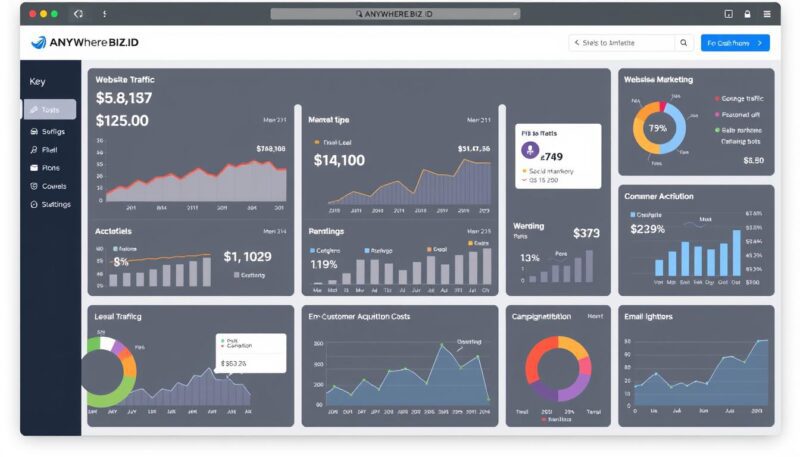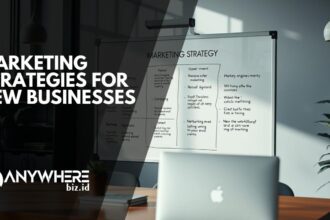Hi, Startup Builder! We know marketing plans can feel tough—but at ANYWHERE.BIZ.ID, we’re here to simplify it for you.
Are you tired of marketing plans that don’t work? Do you want to make your marketing efforts successful? There’s a way to make your marketing plans work every time.
A strategic marketing plan is your guide to success. It’s not just a document. It’s a plan that makes your brand grow.
In this how to write a marketing plan guide, we’ll show you how to write a marketing plan that works. It doesn’t matter if you’re starting a new business or updating your plan. These tips will help you feel confident in your marketing skills.
Must-Know Tips Before You Plan
- Crafting a powerful marketing plan is essential for businesses to drive results.
- A strategic marketing planning process helps achieve marketing goals.
- A marketing plan serves as a roadmap for marketing efforts.
- Understanding your target audience is key for a successful marketing plan.
- Measuring the success of your marketing initiatives is vital.
- A well-crafted marketing plan helps navigate today’s competitive market.
The Importance of a Well-Crafted Marketing Plan
A good marketing plan is key for growing your business. It guides your marketing to reach your goals.
Why Every Business Needs a Strategic Marketing Plan
Every business, big or small, needs a marketing plan. A good plan helps you know your audience and find market chances. It makes your brand stand out and sets goals for 1-3 years.
How an Effective Marketing Plan Drives Business Growth
A good marketing plan helps your business grow. It makes sure all marketing works together well. This way, you get the most from your money.
By checking and changing the plan often, you can keep up with market changes. This helps you meet your goals.
Real-World Success Stories from Effective Planning
Think of a small business that sold 20% more in six months. They used a focused marketing plan.
“Our marketing plan helped us find and talk to our perfect customer. This led to big sales growth,”
the owner said. Stories like this show how planning can make a big difference.
Learning about the value of a good marketing plan is the first step. It helps you grow your business and reach your marketing goals.
How to Write a Marketing Plan That Actually Works
A good marketing plan is like a map for your marketing. It helps you stay on track and reach your goals. This way, you can see how well you’re doing.
Key Components Every Marketing Plan Must Include
A solid marketing plan has a few key components. It starts with a deep look at the market and who you’re trying to reach. It also has a plan for how you’ll market your products or services.
Different Types of Marketing Plans for Various Business Needs
Every business is different, and so are their marketing plans. Knowing the types of plans helps you pick the best one for your business.
Short-term vs. Long-term Marketing Planning
Marketing plans can be short-term or long-term. Short-term plans aim for quick wins. Long-term plans are for growth over time. It’s good to have both for quick results and long-term success.
Digital vs. Traditional Marketing Plan Approaches
Businesses can choose between digital and traditional marketing. Digital plans use the internet, like social media. Traditional plans use old-school methods, like print ads. Mixing both can make a strong marketing plan.
Learning how to write a marketing plan and matching it to your business needs is key. This way, you can make a plan that really works.
Preparing for Your Marketing Plan Development
Before you start making a marketing plan, get ready well. This step is key to making a strong marketing strategy. It must match your business goals.
Essential Resources and Information for Marketing Plan Creation
To make a good marketing plan, you need some important things. You’ll need market research, customer info, and data on your competitors and sales. These help you make smart choices and create a plan just for you.
Key resources to gather:
- Market research reports
- Customer feedback and surveys
- Competitor analysis reports
- Sales data and customer behavior insights
Setting Realistic Timeframes for Your Marketing Plan
It’s important to set realistic times for your marketing plan. Think about how hard the tasks are, what you have to work with, and any possible problems. This helps you make a good timeline.
Marketing Plan Templates and Tools to Streamline the Process
Using marketing plan templates and tools can make things easier. Tools like Plaky help you keep track of tasks and work together better.
| Tool | Description | Benefits |
|---|---|---|
| Plaky | Project management tool for task organization and progress tracking | Enhances team collaboration, improves task management |
| Marketing Plan Template | Pre-designed template for creating a marketing plan | Saves time, ensures all marketing elements are covered |
With good preparation and the right tools, you can make a marketing plan. It will help your business grow and meet your marketing goals.
Step 1: Define Your Business and Marketing Objectives

Your marketing plan’s success depends on clear goals. It’s key to know how your marketing goals match your business vision.
Aligning Marketing Goals with Your Business Vision
Linking your marketing goals with your business vision is important. It makes sure your marketing helps reach your big business goals. For example, if you want to grow, your marketing should aim to find new customers.
Setting SMART Marketing Objectives That Drive Results
Setting SMART (Specific, Measurable, Achievable, Relevant, Time-bound) marketing goals is key. SMART goals give a clear plan for your marketing. They make sure every step is clear and can be tracked.
For example, instead of saying “get more website visitors,” aim for “get 20% more website visitors in 6 months with SEO and content.”
Case Study: How Objective Setting Transformed a Struggling Business
A small e-commerce business was struggling. It set clear, SMART marketing goals. These included more social media engagement and more sales.
Thanks to these goals, the business improved a lot. It became more known and made more sales. This changed the business for the better.
By setting clear marketing goals, you can make a marketing plan that works well. It will help you reach your business goals.
Step 2: Conduct a Comprehensive Market Analysis

Market analysis is key to a good marketing plan. It gives you the info you need to make smart choices. You learn about your audience, competitors, and trends in your field.
Researching Your Target Market Effectively
To really get to know your target market, you need to collect data. This includes demographics, likes, and how they act. You can do this with surveys, focus groups, and looking at what customers say. Knowing your target market lets you make your marketing just for them.
For example, a company that sells outdoor gear looks at age, where people live, and what they like. They also check out what customers say to see what’s popular.
Analyzing Competitors and Industry Trends
Looking at your competitors means finding out what they’re good at, what they’re not, and how they market. You can watch their social media, website visits, and how they talk to customers. Keeping up with trends helps you plan your marketing better.
For instance, you can see how your competitors use social media. Tools like Hootsuite or Sprout Social can show you how well they do and what they post.
Identifying Market Opportunities and Threats Using SWOT Analysis
A SWOT analysis helps you find out what’s good and bad about your business. It also shows you chances and dangers. This way, you can make better choices.
| SWOT Component | Description | Example |
|---|---|---|
| Strengths | Things that help your business | Well-known brand |
| Weaknesses | Things that might hurt your business | Not enough money |
| Opportunities | Chances outside your business | Entering new markets |
| Threats | Things outside that could harm your business | More competition |
Knowing these things helps you use your strengths, fix your weaknesses, grab opportunities, and avoid dangers.
Step 3: Develop Your Target Audience Personas
It’s key to know your target audience well. This helps you make your marketing better. Creating detailed customer personas lets you understand what they need and want.
Creating Detailed Customer Profiles for Marketing Success
To make good customer personas, you need to collect and study data. This data includes who they are, what they buy, and more. Detailed customer profiles help you make your marketing messages fit their needs.
Understanding Customer Pain Points and Needs
It’s important to know what your audience struggles with and what they want. This way, you can make your products or services solve their problems.
Practical Methods for Gathering Valuable Customer Insights
There are many ways to get useful customer insights. You can use surveys, focus groups, and website analytics. Surveys give you direct feedback. Website analytics show how they act online.
| Method | Description | Benefits |
|---|---|---|
| Surveys | Direct feedback from customers through questionnaires. | Provides specific, actionable insights. |
| Focus Groups | Group discussions to gather opinions and feedback. | Offers qualitative insights into customer attitudes. |
| Website Analytics | Analysis of customer behavior on your website. | Provides data on customer behavior and preferences. |
Step 4: Craft Your Marketing Strategy and Messaging
A good marketing strategy and message are key. They help you stand out and grab your audience’s attention. This step is important because it shows how you’ll reach your audience and meet your marketing goals.
Developing a Compelling Unique Value Proposition
Your unique value proposition (UVP) makes you different from others. It’s the special thing you offer that others don’t. To make a great UVP, you must know what your customers want and like.
For example, Warby Parker offers stylish, affordable glasses. They also help others, which makes them stand out.
Creating Consistent Brand Messaging That Resonates
Your brand messaging should be the same everywhere. This builds trust and makes people recognize your brand. You need a clear, simple message that shows what makes you special.
Apple’s message is about being new, simple, and caring for customers. This message really connects with their fans.
Selecting the Right Marketing Channels for Your Audience
Picking the right marketing channels is key. You need to know where your audience is and how they like to get info. For example, young adults like Instagram and TikTok more than old ads.
With a smart marketing plan and message, you can make your business stand out. You’ll build a strong brand and connect well with your audience.
Step 5: Set Your Marketing Budget and Resource Allocation

It’s important to use your resources well to get the best return on your marketing. You need a good plan for your marketing budget and how to use your resources. This means figuring out how much to spend on marketing and where to spend it for the best results.
Determining Realistic Marketing Budgets for Maximum ROI
To set a realistic marketing budget, you must know the costs of your marketing plans. Watch out for small expenses that can add up fast. Use past data and what others in your field spend to help you decide.
“A budget is telling your money where to go instead of wondering where it went.” This quote shows why having a clear budget plan is so important.
Strategic Resource Allocation Across Marketing Channels
After setting your budget, you need to decide how to use your resources. Look for the marketing channels that will best reach your audience and get results.
Cost-Effective Marketing Approaches for Limited Budgets
If you have a small budget, you need to find ways to market that don’t cost too much. Think about using digital marketing like social media and email. These can be very effective and don’t cost as much.
Step 6: Create an Implementation Timeline and Action Plan
Success in marketing needs a good plan. This step turns your ideas into real tasks. It makes sure your marketing works well.

Developing a Comprehensive Marketing Calendar
A good marketing calendar is key. It organizes your marketing plans. It makes sure everything is in the right place at the right time.
Key elements to include in your marketing calendar:
- Campaign start and end dates
- Content publication schedule
- Social media posting schedule
- Email marketing campaigns
- Promotional events and webinars
Assigning Clear Responsibilities and Achievable Deadlines
It’s important to know who does what. Each task needs a person and a deadline. This keeps everyone on track.
| Task | Responsible Team Member | Deadline |
|---|---|---|
| Create social media campaign | Social Media Manager | Two weeks before launch |
| Design promotional materials | Graphic Designer | One week before launch |
| Launch campaign | Marketing Manager | Launch Day |
Setting Up Efficient Workflow and Approval Processes
Good workflow and approval are key. They make sure things go smoothly. For example, a blog post needs approval before it’s published.
By following these steps, you can make a strong plan. This will help your marketing strategy succeed.
Step 7: Establish Metrics and Monitoring Systems

The seventh step is to track your progress and adjust your plan. It’s important to measure how well your marketing works. This helps you make smart choices based on data.
Selecting Relevant Key Performance Indicators (KPIs)
To track your marketing, pick KPIs that match your goals. These could be website visits, social media likes, or how many leads you get. Make sure your KPIs are SMART for the best results.
Some common KPIs for marketing are:
- Website traffic and page views
- Social media metrics (e.g., followers, engagement rate)
- Lead generation and conversion rates
- Email marketing metrics (e.g., open rate, click-through rate)
Implementing Effective Tracking and Reporting Tools
After picking your KPIs, find tools to track them. You might use Google Analytics or marketing platforms. Regular reports help you see how well you’re doing.
Creating a Framework for Ongoing Marketing Plan Adjustments
Your marketing plan should grow with your business. Keep checking your KPIs and tweak your plan as needed. This keeps your marketing strong and on track.
Set a time to review your marketing, like every month or year. This lets you see what’s working and what’s not. You might change who you’re targeting or how you reach them.
Step 8: Common Mistakes to Avoid When Writing a Marketing Plan
Creating a good marketing plan needs careful thought. If you ignore important parts, your plan might not work. This can make your marketing efforts fail.
One big mistake is not doing enough market research. Knowing your audience, competitors, and trends is key. Without this, your marketing might not hit the mark.
Overlooking Thorough Market Research and Analysis
Good market research finds chances and challenges. It helps make marketing that speaks to your audience. Focus on:
- Knowing what customers need and want
- Looking at what competitors do and what’s missing
- Keeping up with industry trends and forecasts
Setting Unrealistic Marketing Goals and Timelines
Setting goals that are too high can be a letdown. Make sure your goals are SMART. They should match your business goals.
For example, expecting too much too soon can hurt. Break big goals into smaller steps.
Failing to Adapt Your Marketing Plan to Market Changes
Markets change fast, and so do what people want. Not updating your plan can make it outdated. Keep checking and tweaking your plan to stay on track.
Signs you need to change include:
- Less people are engaging or buying
- People’s wants or trends are changing
- New competitors show up
Knowing these mistakes and avoiding them helps make a strong marketing plan. This plan can help your business grow.
Final Thoughts – Time to Start Planning
Creating a successful marketing strategy means having a good marketing plan. At ANYWHERE.BIZ.ID, we showed you 8 steps to make a plan that grows your business. By following these steps, you can make a plan that fits your business needs.
Being flexible is important for a good marketing plan. Your plan should change as the market does. Check and update your plan often to keep on track and reach your goals.
Now you know how to write a detailed marketing plan. It’s time to use what you’ve learned. Start making your marketing better today and see your business grow.
FAQ
What is a marketing plan, and why is it essential for businesses?
A marketing plan is a roadmap for a company’s marketing efforts. It helps businesses stay ahead, grow, and meet their goals.
How do I determine the key components of a marketing plan?
A good marketing plan includes market analysis, target audience, marketing mix, and SMART goals. Knowing these helps businesses make strong marketing plans.
What are the different types of marketing plans, and how do I choose the right one?
There are short-term and long-term plans, digital and traditional ones. Choose one that fits your company’s needs and goals.
How do I set realistic marketing objectives that drive results?
Setting SMART goals is key to success. Make sure your marketing goals match your company’s vision for better results.
What is the importance of conducting a thorough market analysis?
Market analysis is vital. It involves studying your target market, competitors, and trends. It helps you spot opportunities and threats.
How do I develop a compelling unique value proposition?
A unique value proposition sets you apart. It’s about understanding customer needs and creating a message that speaks to them.
What are the common mistakes to avoid when writing a marketing plan?
Don’t skip market research or set unrealistic goals. Also, be ready to adjust your plan as the market changes.
How do I measure the success of my marketing plan?
Use metrics and monitoring systems to track your plan’s success. Choose the right KPIs and tools to follow your progress.
Yay! 🎉 You made it to the end of the article!











